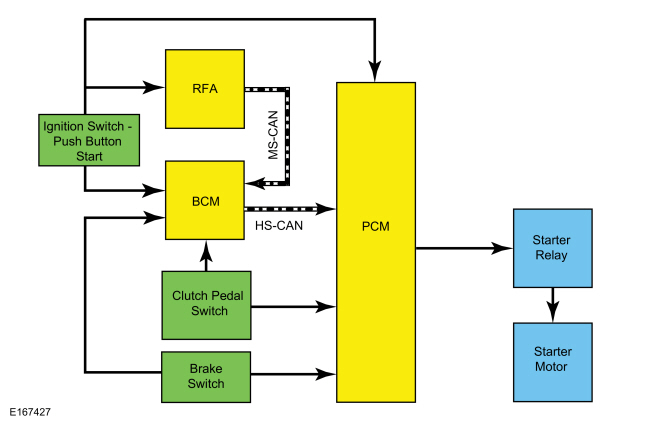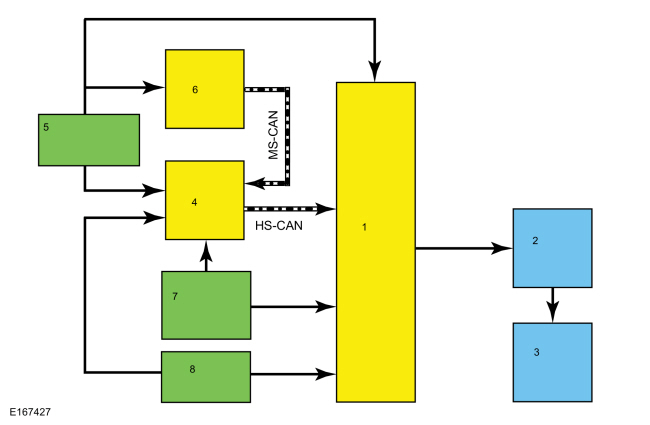Ford Fiesta: Starting System - 1.6L EcoBoost (132kW/180PS) – Sigma / Starting System - System Operation and Component Description. Description and Operation
System Diagram

| Item | Description |
|---|---|
| 1 | PCM |
| 2 | Starter Relay |
| 3 | Starter Motor |
| 4 | BCM |
| 5 | Ignition Switch - Push Button Start |
| 6 | RFA |
| 7 | Clutch Pedal Switch |
| 8 | Brake Switch |
System Operation
Network Message Chart
Module Network Input Messages Powertrain Control Module (PCM)
| Broadcast Message | Originating Module | Message Purpose |
|---|---|---|
| Crank request | BCM | Provides the PCM with indication that the driver has commanded the engine to crank. |
| Power mode | BCM | Provides the PCM with ignition mode. |
Module Network Input Messages Body Control Module (BCM)
| Broadcast Message | Originating Module | Message Purpose |
|---|---|---|
| Intelligent access system status | RFA module | The response from the BCM request for the RFA module ID. If the RFA module ID response is incorrect, then the PATS is disabled. |
Push Button Start System
This vehicle is equipped with a PATS that disables the engine from
cranking if an unprogrammed PATS key is used or an invalid PCM ID is
received. The PATS is controlled by the BCM . If there is a PATS concern
that causes the engine to be disabled, the IPC displays the
corresponding message in the message center. For additional information,
Refer to: Passive Anti-Theft System (PATS) - System Operation and
Component Description (419-01C Passive Anti-Theft System (PATS) -
Vehicles With: Keyless Entry and Push Button Start, Description and
Operation).
Ignition modes are controlled by the RFA module and the BCM . For
additional information on the ignition switch - push button start modes,
Refer to: Steering Wheel and Column Electrical Components - System
Operation and Component Description (211-05 Steering Wheel and Column
Electrical Components, Description and Operation).
The ignition switch - push button start is connected to the RFA module and the BCM as a backup in case of a failure. If there is a circuit failure to either module from the ignition switch - push button start, the modules communicate the ignition switch - push button start request to each other over the Medium Speed Controller Area Network (MS-CAN).
During a start event the Engine Start/stop button is pressed in combination with the clutch pedal input. The RFA module, the BCM and the PCM receive a request to start the engine. The PCM recognizes the correct inputs and provides voltage and ground to energize the starter relay coil and close the starter relay contacts. The starter relay contacts close, providing voltage to the starter solenoid, allowing the starter motor to crank the engine. The PCM disengages the starter motor once an engine Revolutions Per Minute (RPM) threshold is reached, a set crank time is exceeded or the Engine Start/stop button is pressed indicating an engine shutdown request
Component Description
Body Control Module (BCM)
For more information,
Refer to: Passive Anti-Theft System (PATS)
- System Operation and Component Description (419-01C Passive
Anti-Theft System (PATS) - Vehicles With: Keyless Entry and Push Button
Start, Description and Operation).
Passive Key
For more information,
Refer to: Passive Anti-Theft System (PATS)
- System Operation and Component Description (419-01C Passive
Anti-Theft System (PATS) - Vehicles With: Keyless Entry and Push Button
Start, Description and Operation).
Ignition Switch - Push Button Start
The ignition switch - push button start is a momentary contact
switch that is hardwired to the RFA module. The ignition switch - push
button start is used to obtain the OFF, ON or START ignition modes. For
more information,
Refer to: Steering Wheel and Column Electrical
Components - System Operation and Component Description (211-05 Steering
Wheel and Column Electrical Components, Description and Operation).
Remote Function Actuator (RFA) Module
For more information,
Refer to: Passive Anti-Theft System (PATS)
- System Operation and Component Description (419-01C Passive
Anti-Theft System (PATS) - Vehicles With: Keyless Entry and Push Button
Start, Description and Operation).
Powertrain Control Module (PCM)
The PCM provides power and ground to the start relay to initiate cranking of the engine.
 Starting System - Overview. Description and Operation
Starting System - Overview. Description and Operation
Starting System
The
starting system controls the cranking of the engine. The starter motor
is enabled by the starter relay when the relay is activated by the PCM ...
 Starting System. Diagnosis and Testing
Starting System. Diagnosis and Testing
Inspection and Verification
Diagnostics in this manual assume a certain skill level and knowledge of Ford-specific diagnostic practices. REFER to: Diagnostic Methods (100-00 General Information, Description and Operation)...
Other information:
Ford Fiesta 2014 - 2019 Service Manual: Wheel to Hub Runout Minimization. General Procedures
Check NOTE: Wheel-to-hub optimization is important. Clearance between the wheel and hub can be used to offset or neutralize the Road Force® or run-out of the wheel and tire assembly. For every 0.001 inch of wheel-to-hub clearance, the Road Force® can be affected between 1 and 3 pounds depending on the tire stiffness...
Ford Fiesta 2014 - 2019 Service Manual: Wire Terminal Inspection and Removal. General Procedures
Disconnect WARNING: Before beginning any service procedure in this section, refer to Health and Safety Precautions in section 100-00 General Information. Failure to follow this instruction may result in serious personal injury...
Categories
- Manuals Home
- Ford Fiesta Service Manual (2014 - 2019)
- Engine. Assembly
- Engine Component View. Description and Operation
- General Information
- Service Information
- Manual Transmission - 6-Speed Manual Transmission – B6
Rear Wheel Speed Sensor. Removal and Installation
Removal
NOTE: Removal steps in this procedure may contain installation details.
Remove the retainer and pull the rear splash shield outward. Disconnect the electrical connector and detach the wiring retainer.
Disconnect the electrical connector and detach the wiring retainer.

